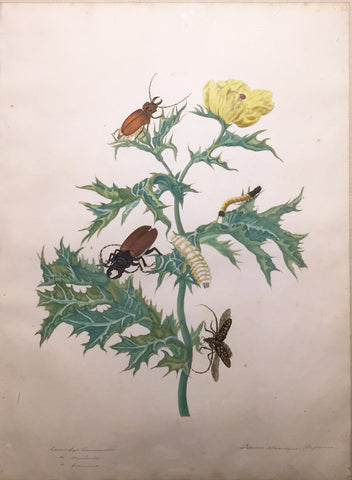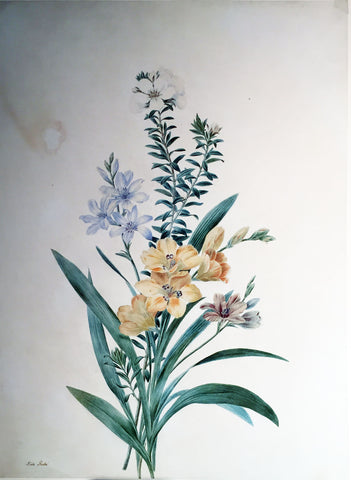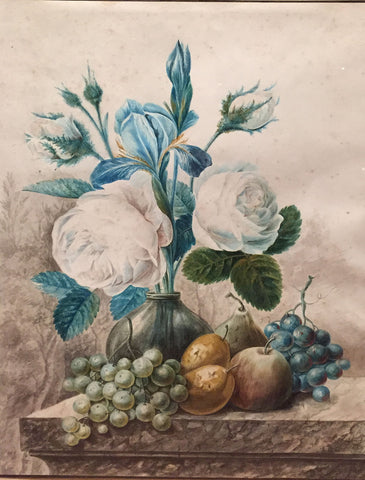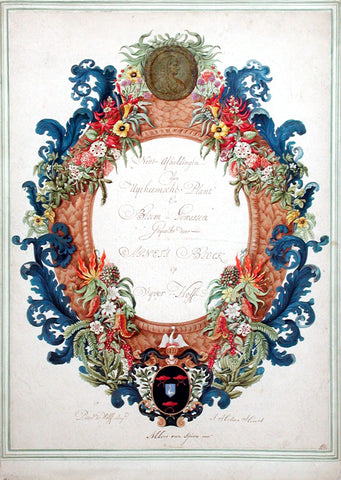
Maria Sibylla Merian (German, 1647-1717), Plate 24. Prickly Poppy, Mexican Poppy or Thistle.
Maria Sibylla Merian (German, 1647-1717)
“Plate 24. Prickly Poppy, Mexican Poppy or Thistle. ”
from The Insects of Surinam
Watercolor and bodycolor with gum arabic over lightly etched outlines on paper. Heightened with gold leaf.
Inscribed in pencil ‘24,’ and in ink ‘Cerambyx Cinammous do spinibarbis de farinosis’ and ‘Papaver spinosum (Argemone)
Amsterdam, 1705
Paper size: 20 1/4 x 14 in.
Transfer-print watercolors from The Insects of Surinam
Merian referred to this plant as “Carduus spinosus,” or prickly thistle because it externally resembles the thistle, but actually belongs to the poppy family. The smaller larva (Elateridae gen. spec.), which she found on the turnip-like root of this plant, is presumably the larva of a click beetle from which the beetle on the stalk (Taeniotes subocellaris) is supposed to have emerged. The fat, whitish grub is the immature form of the Stenodotes spinibarbis, the beetle at the top of the image. Like most larvae of this group, it is found in dead wood. These peropodals feed on loose-bitten slivers of wood which they gnaw off with their powerful jaws. The long-horned beetle (Callipogon barbatus?) depicted here in the center was part of an earlier study by Merian, which included five distinct varieties of beetles and one mistakenly associated larvae.
Descriptions of each plant adapted from J.Harvey’s commentary to the Folio Society facsimile of the Surinam Album (London, 2006) and Merian’s text for the Insects of Surinam.
One glimpse of any of Merian’s transfer-print watercolors from the Insects of Surinam reveals the main reasons for such celebration. Even to those who do not know of her work, this is a stunning sight. Her colors are alternately subtle and vibrant, capturing the quality of her subjects with striking naturalism. Yet while she maintains a scientist’s eye for precision, her creative decisions and compositions give these images a style that is distinctly hers. Each image demonstrates Merian’s masterful grasp of detail and nuance, as well as her outstanding ability to combine science and art. Equally significant, to early 18th century Europeans, her illustrations represented the first views of these American plants and insects.
These spectacular examples of her work are from one of a very few transfer-print watercolor volumes known to exist. Merian herself prepared the volume. After an uncolored print was made, she applied dampened paper to it, pressing by hand to create an image of the print in reverse. In this volume, she chose to block out the plate numbers and then add by hand, to some images, numbers, and notations. Merian then painstakingly watercolored the dried paper herself, ensuring that the colors were true to the specimens she had seen in South America, and also allowing her style to emerge with the greatest clarity. The volume was not meant for sale, and its intended purpose cannot be known with any certainty. Perhaps it was created as a gift for a wealthy and important patron, perhaps Merian meant to keep it herself. What can be stated without a doubt is that these splendid images represent a unique opportunity to acquire original works by an artist who broke barriers as a woman, as a scientist and artist, and whose accomplishments are no less impressive today than they were in her time.
Please feel free to contact us with questions by phone at 215.735.8811,
or by email at loricohen@aradergalleries.
We Also Recommend





